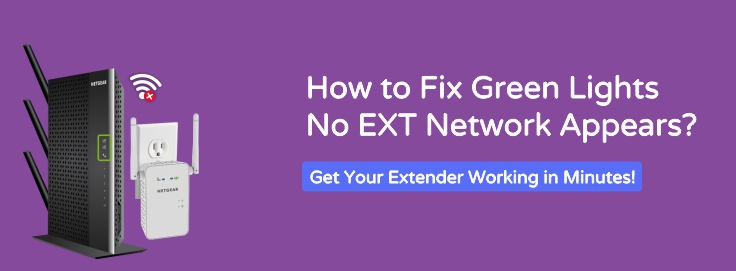Introduction
If your Wi-Fi extender exhibits steady green lights but you fail to see the EXT network on your device, usually the problem could be with the SSID, a faulty Netgear extender setup, or an interference stopping the signal from broadcasting correctly. In essence, the extension seems to be operating but lacks complete connection or configuration.
This may be an unpleasant experience particularly if everything looks to be functioning properly on the surface. The lights indicate one thing; your electronics convey another narrative.
Fortunately, this problem is common and usually easy to fix with a few targeted steps.
In this guide, we’ll break down why this happens and walk you through exactly how to bring your EXT network back to life—without needing to call in tech support.
What Does It Mean When the Lights Are Green?
Let us first straighten anything up. Usually, green lights on your Wi-Fi extension indicate that the system is working properly as it should. The gadget is theoretically transmitting a network and is linked to the router. However, it is not important that y our devices should be working correctly just because the LEDs are green.
Sometimes, an extender may appear to be working—lights and all—but there could be an underlying issue. Either it hasn’t broadcasted the SSID (network name), or the signal is being suppressed due to interference, configuration issues, or even firmware bugs.
Common Causes for the EXT Network Not Showing
Let’s break down the usual suspects:
-
Hidden SSID Setting:
Some extenders have the SSID broadcast turned off by default or after a firmware update. That means the network exists, but it’s invisible to your devices unless you connect manually.
-
Incorrect Netgear extender Setup Sequence:
If the extender wasn’t set up properly—especially if the router connection failed midway—the extender might light up green but not create a functional network.
-
Signal Interference:
Thick walls, microwaves, and other devices on the same frequency can interfere with the extender’s signal, making it too weak to show up.
-
Firmware Glitches:
Even modern extenders occasionally run into bugs. A green light might simply mean the hardware is okay—but the software may need a restart or update.
-
Same Network Name as Router:
If your extender uses the same SSID as your main router, your device will automatically connect to the weaker main signal instead of the stronger EXT one.
Step-by-Step Fix Guide
Let’s move toward the solution guide. Follow the step by step procedure given below:
1. Power Cycle Everything
Turn everything off—your router, your extender, and your device (phone, laptop, etc.). Wait about 30 seconds, then power them back on in this order:
- Router
- Extender
- Device
This simple trick clears temporary bugs and refreshes connections.
2. Check for Hidden Network
- Grab your phone or laptop and go to the Wi-Fi settings.
- Look for an option to connect to a hidden network.
- Enter the EXT network name (check the label on your extender or the user manual) and the password. If it connects, your extender is fine—it’s just set to not broadcast the SSID.
- You can do Netgear extender login to the settings via typing the IP address “192.168.0.1” or URL “mywifiext.net” in the address bar.
- Now, enable SSID broadcast from the wireless settings.
3. Reconfigure the Extender
Your extension could not be exactly linked to the router even if it displays green lights. The arrangement might have glitched. To rework:
- Press and hold the extender’s reset button about five seconds until the lights flicker.
- Connect to the extender with your phone or laptop and visit the Netgear extender setup page to manually proceed through the WPS method—press WPS on the router then on the extension.
Now make sure to assign a different SSID (e.g., “Home_EXT”) to make it easier to identify and connect.
4. Update the Firmware
Perform the Netgear extender login to the extender’s admin page and check for firmware updates. An outdated version could be the reason the network isn’t showing even though the device seems fine.
Every brand is slightly different, but look for a “Firmware Update” or “Software” tab. Follow the on-screen prompts, and don’t unplug the extender during the update.
5. Reduce Interference
Move the extender closer to the router temporarily to test if it’s a signal strength issue. If the network shows up when it’s closer, interference or weak signal could be to blame. Ideally, place your extender:
- Midway between your router and the dead zone
- Away from thick walls, cordless phones, baby monitors, or microwaves
Also, consider switching channels in the settings if you’re on a crowded Wi-Fi band.
6. Factory Reset as a Last Resort
If none of the above works, a full factory reset is your last step. Hold down the reset button for 15 seconds until the lights flash. Then go through the entire Netgear extender setup from scratch. Be patient here—don’t rush it, especially if your extender uses a browser-based configuration.
Bonus Tips
- Use a Different Device to Scan for Wi-Fi: Sometimes it’s your device, not the extender, that’s the issue. Try checking the network from a different phone, tablet, or computer.
- Change the Wi-Fi Band (2.4GHz vs 5GHz): If your extender supports dual-band, the EXT network may only appear on one of them. Try scanning both bands from your device.
- Name Your EXT Network Differently: Giving it a unique name helps avoid confusion and lets you clearly see if your device is connecting to the extender or the main router.
Final Thoughts
Just because your extender is glowing green doesn’t mean it’s doing its job. This is one of those sneaky tech problems that looks fine on the outside but needs a little manual TLC behind the scenes.
Most of the time, it’s a minor configuration issue or a setting that needs to be nudged back into place. Go through the steps above methodically, and don’t be discouraged—these issues are far more common than you think.
Once you’re back up and running, consider logging into your extender settings every now and then for a quick check-in. A minute of upkeep can save you hours of frustration down the road.


